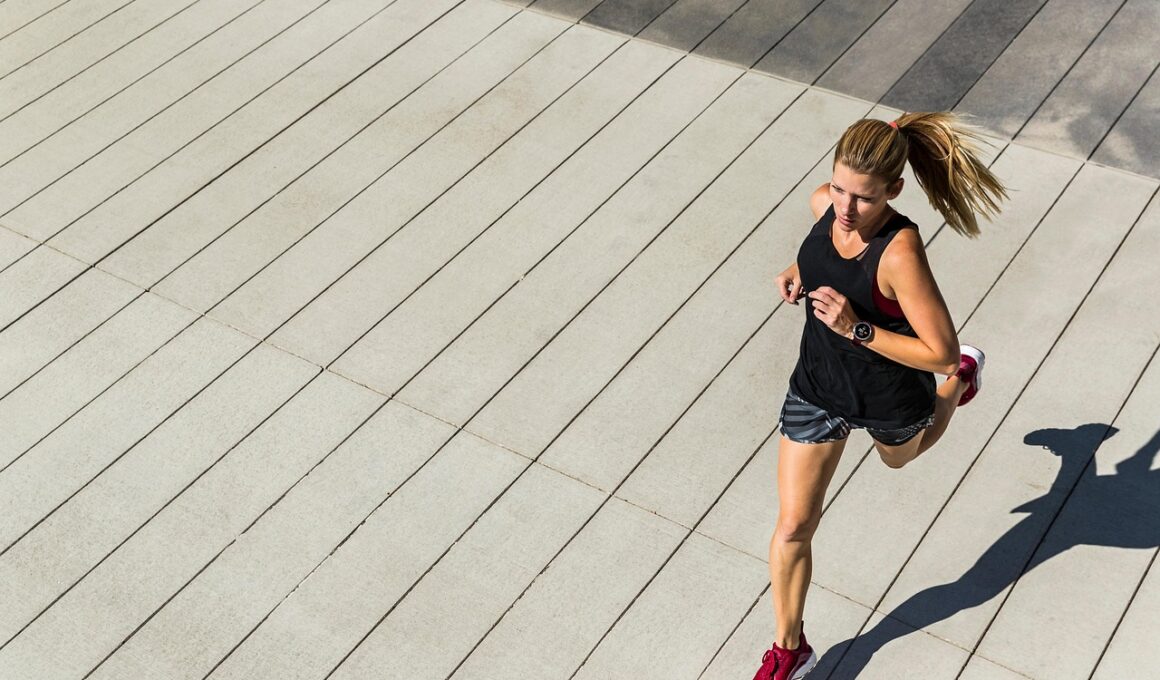The Environmental Benefits of Minimalist Running
Minimalist running introduces a unique approach to footwear and our connection to nature, emphasizing the importance of eco-friendly practices. Traditional running shoes often utilize various environmentally harmful materials throughout their production processes, including synthetic rubber and other plastics. These materials contribute significantly to pollution. Minimalist running emphasizes the use of lightweight, breathable footwear made from organic or recycled materials, which help to reduce the overall carbon footprint. By wearing minimalist shoes or opting for barefoot running, runners can contribute to a healthier planet. Moreover, when we choose sustainable brands, we support a shift towards eco-conscious production methods. These practices also encourage manufacturers to innovate and reduce waste. Additionally, minimalism promotes a closer connection to the ground, further enhancing our appreciation for nature. As runners become more attuned to their surroundings, they may also become more aware of environmental issues, leading to increased advocacy for eco-friendly initiatives. Overall, integrating minimalist running into our lives not only benefits our health but also encourages sustainability and awareness of our ecological impact.
One of the most significant environmental advantages of minimalist running is the reduction of waste associated with running gear. Traditional running shoes typically have a lifespan of about 300 to 500 miles, but their production generates significant waste, from manufacturing to disposal. Minimalist shoes, on the other hand, are often made from durable materials that prolong their use, leading to less frequent replacements. This means that fewer shoes need to be produced over time. Runners who practice minimalism frequently find they own fewer pairs, which reduces shoe waste significantly. Along with that, these shoes are generally easier to recycle, thanks to simpler materials. For instance, many minimalist shoe brands partner with recycling programs that facilitate the repurposing of old footwear. This circular approach minimizes landfill contributions and encourages responsible consumer behavior among athletes. Furthermore, as the industry shifts towards sustainable practices, it motivates other sectors to follow suit. By adopting minimalist running, individuals can inspire friends and family to consider their own environmental impacts, demonstrating the power of personal choices in fostering a healthier planet.
Support for Sustainable Brands
Choosing to go minimalist not only provides personal benefits but bolsters brands that prioritize sustainability in their products. Many companies focusing on minimalist running shoes emphasize environmentally friendly practices in their entire supply chain. These brands often use recycled materials to produce their footwear, minimizing resource consumption and pollution during production. Supporting these companies enables them to expand their eco-conscious initiatives and encourages a broader shift in the industry towards sustainable practices. Additionally, when consumers actively seek out these brands, companies are incentivized to invest more in eco-friendly innovations, such as reducing carbon emissions and using solar energy during production. Eco-friendly minimalists motivate markets by showcasing the demand for responsible production and sustainable products. As a result, this market pressure can lead to significant changes, inspiring other brands to adopt similar, eco-friendly practices. When we recognize and support these efforts, we contribute to creating a stable demand for sustainable products. By choosing to buy from such companies, runners can significantly decrease their ecological footprint while encouraging broader awareness around environmental issues in the running community.
Minimalist running also enhances our connection to the environment, providing an experience that grounds us in our surroundings. When runners opt for barefoot or minimalist footwear, they experience a renewed awareness of the terrain beneath their feet, whether it’s grass, dirt, or gravel. This intimacy with nature cultivates a deeper appreciation for natural landscapes and ecosystems. With each step, the sensing of textures and changes in terrain reminds runners of the vital role nature plays in our lives. As a result, this heightened awareness can encourage runners to act as stewards of the environment, committing to protect the very landscapes they’re engaging with. Many runners find themselves gravitating towards local parks and trails, fostering a sense of community that further promotes environmental responsibility. Engaging in outdoor activities also inspires runners to advocate for local conservation efforts and volunteer initiatives. This implies that minimalist running transcends fitness—it becomes a powerful tool for fostering environmental stewardship. The cumulative effect of these compassionate choices encourages individuals to take action in preserving nature, creating a synergy between our love for running and respect for the environment.
Healthier Outdoor Spaces
Minimalist running encourages individuals to explore and utilize natural spaces, which can catalyze the preservation and rehabilitation of these areas. As more runners embrace the trend of urban running, they should do so consciously, opting to frequent green spaces rather than relying solely on paved surfaces. By prioritizing parks, trails, and other natural settings, runners can show support for these communal areas, promoting projects that invigorate local ecosystems and mitigate urban sprawl. This not only benefits individual health, but also leads to maintaining healthier outdoor environments. When communities recognize the importance of these spaces, local governments may invest more in their upkeep and development. This could include reducing litter, planting trees, or improving sustainable paths for walking and running. Runners’ visibility and engagement in these areas illustrate to policymakers the need for green spaces in urban planning. Through minimalist running, athletes can advocate for healthier environments in their cities and towns, as every step they take serves as a testament to their commitment to preserving nature. Thus, runners support the preservation of ecosystems while enjoying the benefits of cleaner, greener spaces.
Furthermore, minimalist running aligns with the growing trend of eco-tourism, inspiring runners to discover new trails while supporting conservation efforts. Many organizations focus on sustainable travel tours. By participating in local trail runs or eco-friendly races, runners immerse themselves in authentic experiences that emphasize environmental responsibility. These races often promote community engagement, volunteer opportunities, and fundraising for local conservation projects. The combination of running and tourism serves to draw attention to areas needing protection or restoration and highlights the negative consequences of neglect or overdevelopment. Participants can enjoy breathtaking views and pristine settings while contributing their time or resources to the cause. This collaborative spirit fosters awareness not just about minimalist running, but also about environmental stewardship as a whole. As runners share their experiences through social media platforms, a larger community can become engaged in eco-friendly practices, inspiring others to transform their recreational habits. By intertwining running with conservation efforts, minimalists can encourage sustainable travel and foster connections between athletes and the landscapes they cherish, ultimately creating a global impact for the betterment of our environment.
The Future of Running and Sustainability
In conclusion, the environmental benefits of minimalist running extend beyond individual practice. Each runner’s choice to embrace a minimalist approach contributes significantly to a larger movement toward sustainable practices, advocating for environmental awareness. As more people recognize these benefits, the philosophy of minimalism can create a ripple effect that touches every aspect of running culture. The movement encourages manufacturers to prioritize eco-friendly materials, practices, and initiatives, as well as filter into the framework of running events and lifestyle choices. These shifts not only positively impact the environment but also promote healthier living for those who choose to adopt these practices. As runners continue to push for sustainable habits, they’ll actively reduce their ecological footprint and inspire others to follow suit. Together, individuals contribute towards creating a healthier planet and outdoor spaces that future generations can enjoy. Minimalist running is more than just a trend; it’s a philosophy that connects health, fitness, and our shared responsibility for the environment. Ultimately, sharing this journey will bridge the community of runners with the urgency of taking action for sustainable practices around the globe.
As we move forward, it’s essential to encourage discussions about the implications of sustainable running practices. Participating in forums, workshops, or local events can further amplify awareness. Runners can share their insights and tales of discovering minimalist approaches, while also advocating for sustainable choices. Whether through social media platforms, blogs, or casual meetups, discussions can generate excitement and encourage others to make informed choices about their running habits. Building a network of eco-conscious runners creates opportunities to collaborate on preserving the environment, with initiatives ranging from tree planting to local clean-ups. While the transition might seem small initially, the combined efforts of individuals can lead to substantial changes. Therefore, fostering conversations helps amplify these messages, ultimately solidifying the importance of sustainability within the running community. Minimally-focused running may well emerge as a cornerstone for fitness enthusiasts looking to merge their passion for running with a genuine commitment to environmental stewardship. As we embrace minimalist running, we can relish in the profound benefits of keeping ourselves fit, connecting with nature, and advocating for the sustainability of our cherished environment.


